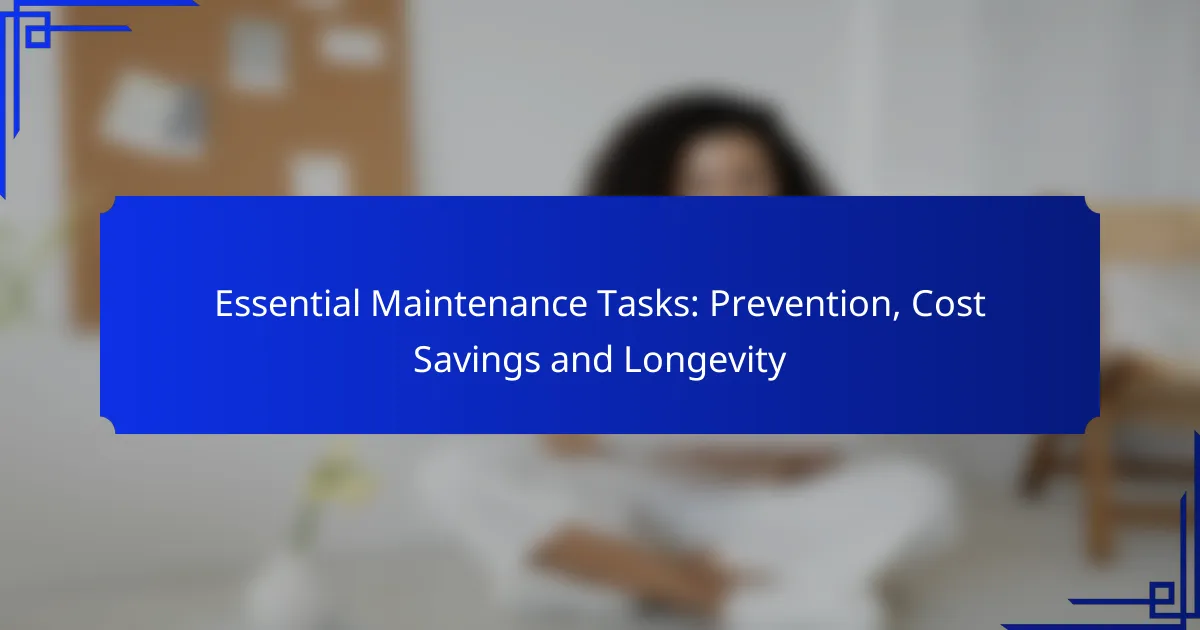Essential maintenance tasks are crucial for the longevity and efficiency of home systems, including HVAC, plumbing, roofing, and electrical components. By conducting regular checks and servicing, homeowners can prevent costly repairs, identify potential issues early, and ultimately save money while extending the lifespan of their equipment.
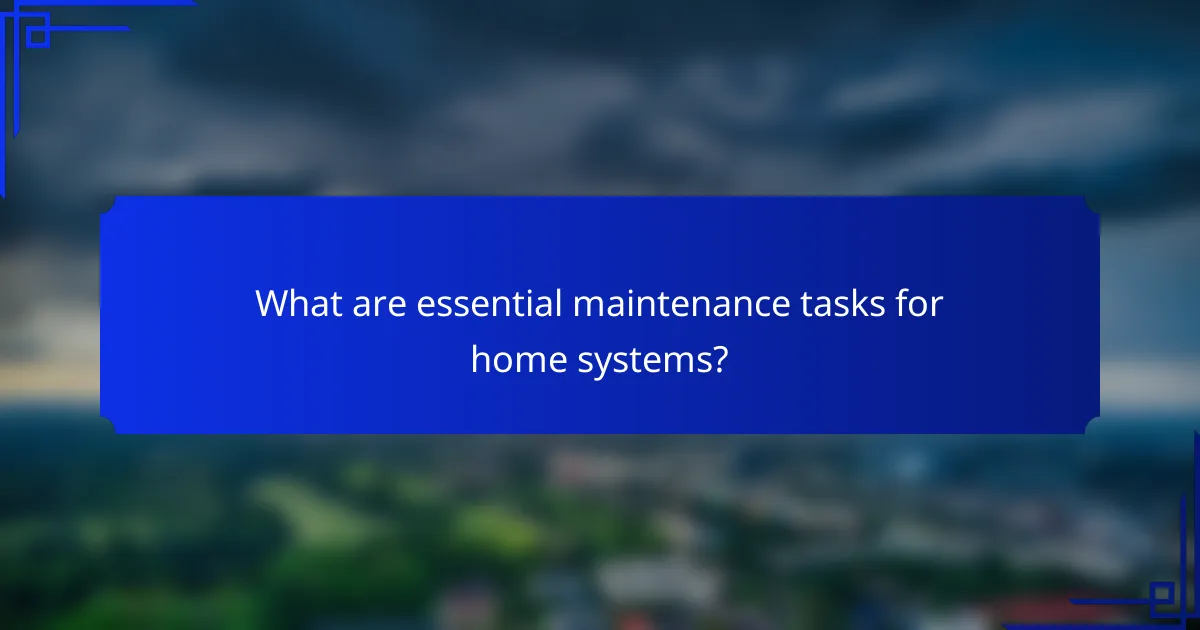
What are essential maintenance tasks for home systems?
Essential maintenance tasks for home systems include regular checks and servicing of HVAC, plumbing, roofing, electrical systems, and appliances. These tasks help prevent costly repairs, enhance efficiency, and extend the lifespan of your home systems.
HVAC system checks
Regular HVAC system checks are crucial for maintaining comfort and efficiency in your home. Schedule inspections at least once a year, ideally before the heating or cooling season begins, to ensure optimal performance.
During these checks, a technician will clean or replace filters, check refrigerant levels, and inspect ductwork for leaks. This proactive approach can save you money on energy bills and prevent unexpected breakdowns.
Plumbing inspections
Plumbing inspections are essential for identifying leaks, clogs, and other issues that could lead to water damage. Inspect your plumbing system at least once a year, focusing on visible pipes, fixtures, and appliances.
Look for signs of wear, such as rust or corrosion, and consider using a professional for a more thorough evaluation. Addressing minor issues early can prevent costly repairs and water waste.
Roof maintenance
Roof maintenance involves regular inspections and repairs to ensure your roof remains in good condition. Check your roof at least twice a year, especially after severe weather, to identify missing shingles or signs of leaks.
Keep gutters clean and clear to prevent water damage and ensure proper drainage. Regular maintenance can extend the life of your roof and protect your home from costly water damage.
Electrical system evaluations
Electrical system evaluations are vital for safety and efficiency. Have a qualified electrician inspect your system every few years, focusing on wiring, outlets, and circuit breakers.
Look for signs of wear, such as flickering lights or tripped breakers, which may indicate underlying issues. Regular evaluations can help prevent electrical fires and ensure your system meets current safety standards.
Appliance servicing
Appliance servicing includes routine checks and maintenance to keep your appliances running efficiently. Schedule servicing for major appliances like refrigerators, washers, and dryers at least once a year.
During servicing, technicians can clean components, check for wear, and ensure appliances operate within manufacturer specifications. This can help prevent breakdowns and extend the lifespan of your appliances, saving you money in the long run.
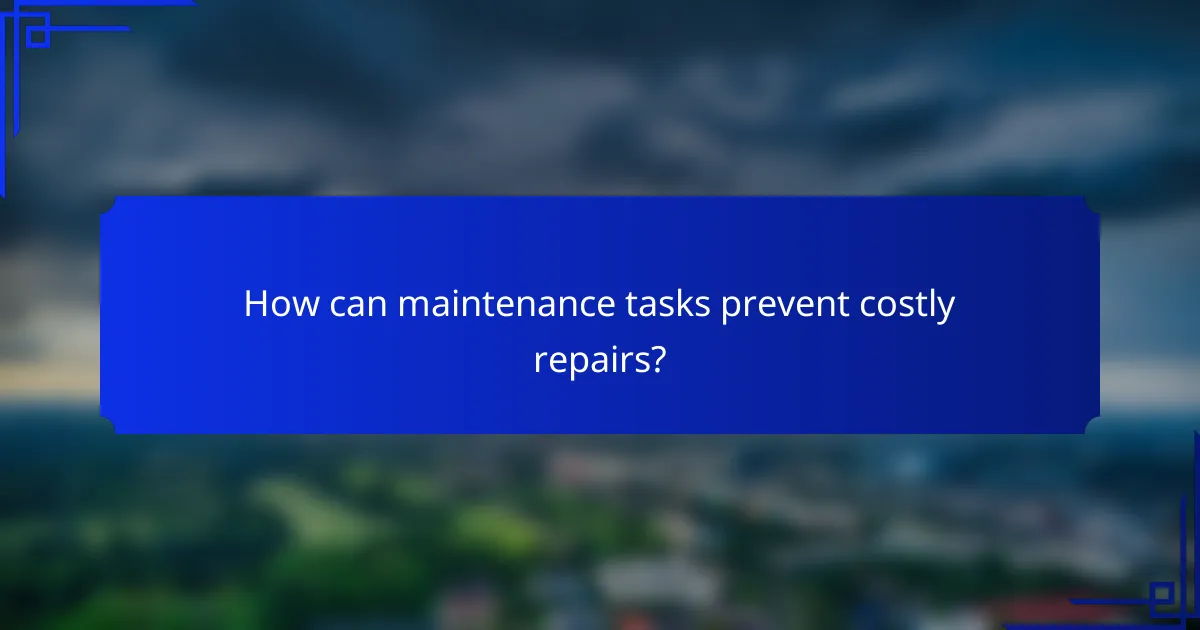
How can maintenance tasks prevent costly repairs?
Regular maintenance tasks are essential for preventing costly repairs by identifying potential issues before they escalate. By addressing small problems early, you can save significant amounts on extensive repairs and extend the lifespan of your equipment.
Early detection of issues
Early detection of issues allows for timely interventions that can avert major breakdowns. Routine inspections and maintenance can reveal wear and tear, leaks, or other anomalies that might otherwise go unnoticed. For instance, checking HVAC systems regularly can prevent costly failures during peak usage seasons.
Implementing a schedule for maintenance checks can help ensure that all critical components are evaluated consistently. Consider using checklists to track inspections and repairs, which can help in identifying recurring problems that may need more attention.
Improved system efficiency
Regular maintenance enhances system efficiency, which can lead to lower operational costs. Well-maintained equipment typically operates at optimal performance levels, reducing energy consumption and minimizing waste. For example, cleaning air filters in HVAC systems can improve airflow and decrease energy costs by up to 15%.
To maintain efficiency, consider adopting a proactive maintenance strategy that includes routine cleaning, lubrication, and calibration of machinery. This approach not only keeps systems running smoothly but also helps in identifying inefficiencies that could lead to higher costs.
Extended lifespan of equipment
Consistent maintenance tasks can significantly extend the lifespan of equipment, delaying the need for costly replacements. For example, regularly changing oil in engines can prevent damage and prolong their operational life. This can save thousands of dollars in replacement costs over time.
To maximize equipment longevity, establish a maintenance schedule that aligns with manufacturer recommendations. Keeping detailed records of maintenance activities can also help track the condition of equipment and inform future maintenance decisions, ensuring that all assets are utilized efficiently and effectively.
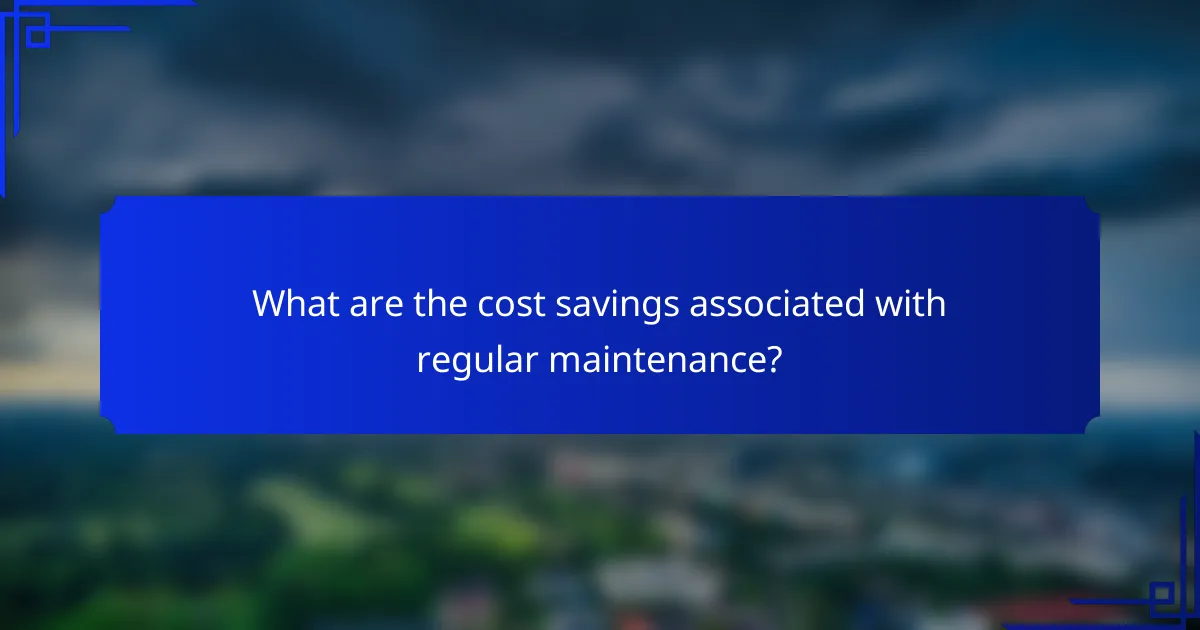
What are the cost savings associated with regular maintenance?
Regular maintenance can lead to significant cost savings by enhancing efficiency and preventing costly breakdowns. By investing in routine upkeep, property owners can minimize unexpected expenses and extend the lifespan of their assets.
Reduced energy bills
Regular maintenance helps ensure that systems like heating, ventilation, and air conditioning (HVAC) operate at peak efficiency. For instance, cleaning or replacing air filters can improve airflow and reduce energy consumption, leading to lower monthly utility bills.
In many cases, homeowners can see energy savings of around 10-20% through consistent maintenance practices. Simple tasks like sealing leaks, insulating ducts, and maintaining appliances can contribute to these reductions.
Avoidance of emergency repairs
Proactive maintenance can prevent emergency repairs, which often come with higher costs and inconvenience. For example, regularly inspecting plumbing systems can catch leaks before they escalate into major water damage.
By addressing minor issues early, homeowners can save hundreds or even thousands of dollars compared to the costs associated with emergency services. Scheduling routine inspections can help identify potential problems before they require urgent attention.
Lower replacement costs
Maintaining equipment and systems can significantly extend their lifespan, delaying the need for costly replacements. For example, regularly servicing a furnace can add years to its operational life, pushing back the replacement timeline.
Replacing major appliances or systems can be a substantial financial burden, often costing thousands of dollars. By investing in regular maintenance, property owners can avoid premature replacements and enjoy better long-term value from their investments.

How do maintenance tasks contribute to longevity?
Maintenance tasks are essential for extending the lifespan of equipment and structures. By regularly addressing wear and tear, you can prevent costly breakdowns and ensure optimal performance over time.
Regular servicing schedules
Establishing regular servicing schedules is crucial for maintaining longevity. Routine inspections and maintenance help identify potential issues before they escalate, allowing for timely repairs. For example, vehicles often require oil changes every 5,000 to 7,500 miles to function efficiently.
Creating a maintenance calendar can help keep track of necessary tasks and ensure they are performed consistently. This proactive approach not only enhances performance but also reduces the likelihood of unexpected failures.
Quality of materials used
The quality of materials used in construction or manufacturing directly impacts longevity. High-quality materials tend to withstand environmental stressors better and require less frequent replacement. For instance, using stainless steel instead of regular steel can significantly increase the lifespan of outdoor structures.
When making purchasing decisions, consider investing in durable materials that may have a higher upfront cost but offer long-term savings through reduced maintenance and replacement needs.
Environmental factors
Environmental factors play a significant role in the longevity of equipment and structures. Elements such as humidity, temperature fluctuations, and exposure to corrosive substances can accelerate wear and tear. For example, coastal areas with high salt exposure may require more frequent maintenance for metal structures.
To mitigate these effects, consider protective coatings or treatments that can enhance durability. Additionally, understanding the local climate can guide maintenance schedules and material choices to better suit specific environmental conditions.
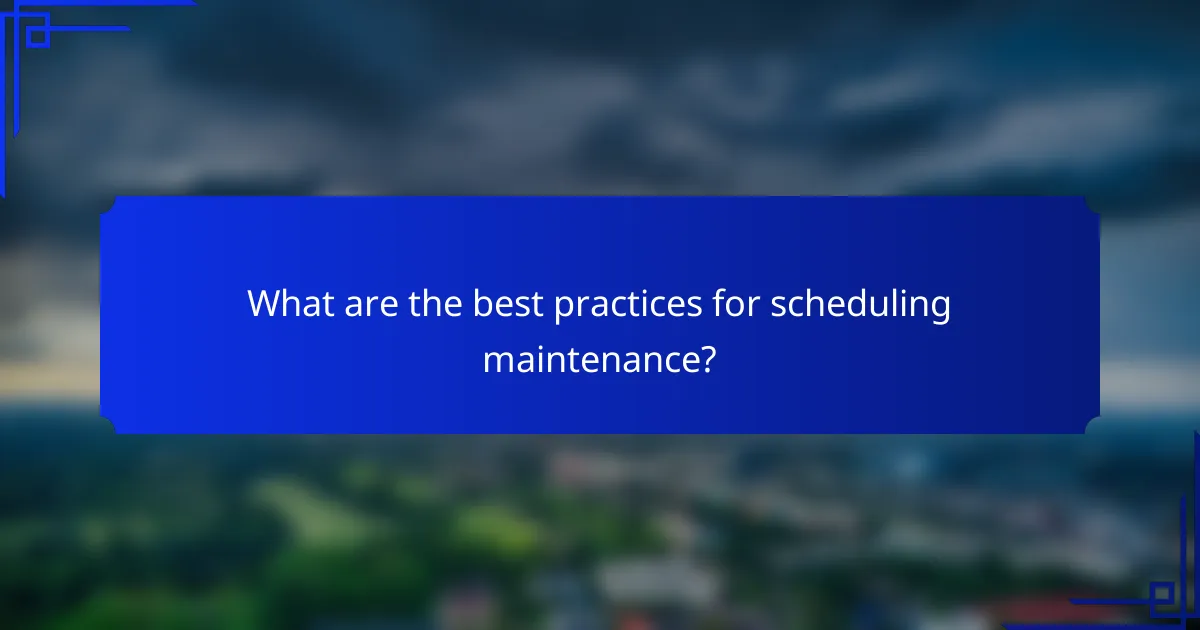
What are the best practices for scheduling maintenance?
Effective maintenance scheduling involves planning tasks at regular intervals to prevent breakdowns and extend equipment lifespan. Best practices include assessing equipment needs, prioritizing tasks, and utilizing a maintenance management system for tracking.
Assessing Equipment Needs
Begin by evaluating the specific requirements of your equipment. Consider factors such as usage frequency, manufacturer recommendations, and historical performance data. This assessment helps determine which machines require more frequent maintenance and which can be serviced less often.
Utilize tools like condition monitoring to gather real-time data on equipment performance. This proactive approach allows for adjustments in the maintenance schedule based on actual conditions rather than just time intervals.
Prioritizing Tasks
Once you have assessed equipment needs, prioritize maintenance tasks based on their impact on operations and safety. Critical equipment that directly affects production should be serviced first, while less crucial items can be scheduled later.
Consider using a risk-based approach to prioritize tasks. This means evaluating the potential consequences of equipment failure and scheduling maintenance accordingly to minimize downtime and costs.
Utilizing a Maintenance Management System
Implement a maintenance management system (MMS) to streamline scheduling and tracking. An MMS can automate reminders for upcoming maintenance tasks and provide insights into maintenance history and costs.
Choose a system that allows for easy updates and reporting. This will help you adjust schedules based on changing operational needs and ensure that all maintenance activities are documented for future reference.
